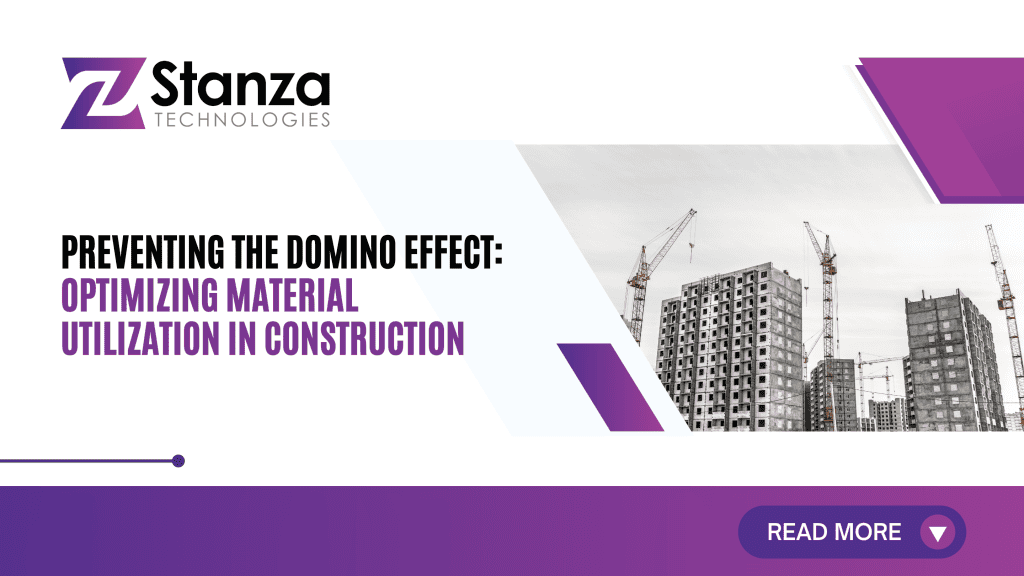In the intricate web of the construction industry, every element is interconnected, much like a series of dominoes. When one piece falters, it creates a chain reaction that impacts the entire project. Poor material utilization is often the first domino to fall, leading to a cascade of issues, including overspending and compromised sustainability planning. This interconnected nature of construction projects highlights the importance of precision, planning, and the right technological solutions.
Poor material utilization begins with inefficient planning and inaccurate measurements, often due to reliance on outdated methods or insufficiently integrated technology. This initial misstep leads to over-ordering or under-ordering materials, resulting in waste and additional costs. These excess expenses quickly enter the project budget, creating financial strain and leaving less room for sustainable practices.
As costs spiral out of control, project timelines are inevitably affected. Delays occur as contractors scramble to reorder materials or adjust to shortages, leading to scheduling conflicts and extended project durations. This domino effect also extends to labor costs, with workers idled or inefficiently deployed, exacerbating budget overruns.
Moreover, when budgets are stretched thin, sustainability planning often takes a backseat. Funds that could have been allocated to environmentally friendly materials or energy-efficient technologies are instead diverted to cover unexpected material costs. This shift undermines the project’s sustainability goals and tarnishes the company’s reputation and compliance with environmental regulations.
Poor material utilization also results in poor quality. To compensate for overspending, project managers might resort to cheaper, inferior materials, compromising the overall integrity and safety of the construction. This decision has long-term repercussions, leading to increased maintenance costs and potential safety hazards, further straining the project’s financial viability.
So, how can the construction industry prevent this domino effect? The key lies in adopting comprehensive software solutions and leveraging the expertise of Building Information Modeling (BIM) professionals.
Firstly, finding the right software solutions that cater to all aspects of a construction project is crucial. An integrated construction management software can provide a centralized planning, scheduling, budgeting, and resource management platform. Such software ensures that every project phase is aligned, from initial design to completion. By utilizing a unified system, construction companies can improve communication, streamline processes, and reduce the risk of errors that lead to poor material utilization.
The right software solutions also offer real-time data analytics and reporting, enabling project managers to make informed decisions quickly. With access to accurate, up-to-date information, teams can adjust plans proactively, minimizing waste and avoiding costly delays. Furthermore, advanced features like automated material tracking and inventory management help ensure that suitable materials are available when needed, reducing the risk of over-ordering or running out.
Secondly, the role of BIM experts is indispensable in this technological transformation. BIM professionals use sophisticated modeling tools to create precise digital representations of a project’s physical and functional characteristics. This level of detail allows for accurate measurement and material estimation, ensuring that the exact quantities are ordered and utilized efficiently.
BIM technology goes beyond simple 3D modeling; it integrates data from various sources to provide a comprehensive project view. This holistic approach helps determine potential issues before they arise, allowing for better planning and coordination. For instance, BIM can simulate different construction scenarios, highlighting the most efficient material usage patterns and identifying areas where waste can be minimized.
Moreover, BIM experts can collaborate with other stakeholders, such as contractors, engineers, architects, and the like, to ensure everyone is on the same page. This collaborative effort reduces misunderstandings and ensures that every aspect of the project is considered, further enhancing material utilization and overall project efficiency.
The domino effect of poor material utilization in construction is a complex but avoidable issue. By embracing integrated software solutions and leveraging the expertise of BIM professionals, the construction industry can mitigate overspending, adhere to sustainability goals, and ensure high-quality project outcomes. The interconnected nature of construction projects demands a proactive and holistic approach, where every piece of the puzzle is carefully considered and managed to prevent the collapse of the entire structure.










